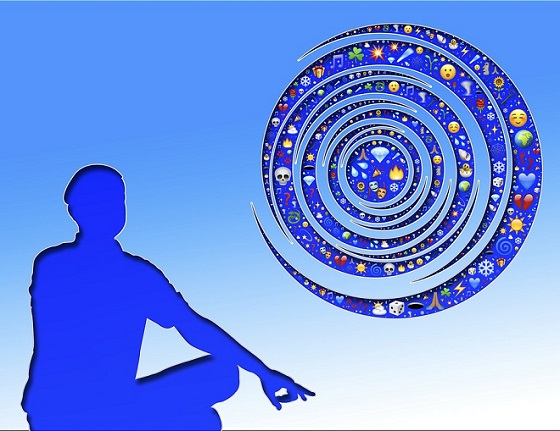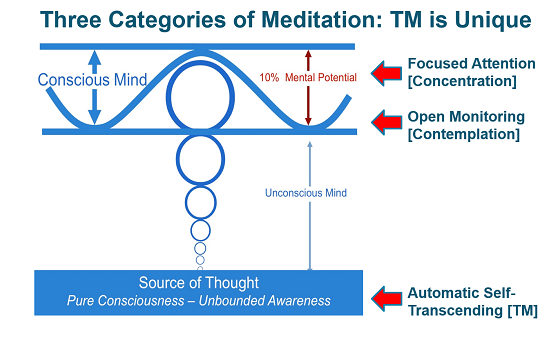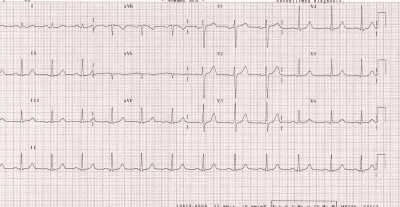
Are there fundamental differences between the various meditation practices—or are all meditation techniques essentially the same?
After more than 40 years of scientific research, scientists have concluded that there are distinct differences in meditation practices, specifically with regard to their effects on the brain and body, and their outcomes.
In a paper published in Consciousness and Cognition in 2010*, Dr. Fred Travis and Dr. Jonathan Shear reviewed the research on the differences among meditation techniques. The doctors organized meditation techniques into three categories: Focused-Attention, Open-Monitoring, and Automatic Self-Transcending.
* Travis, F., & Shear, J. (2010). Focused attention, open monitoring, and automatic self-transcending: Categories to organize meditations from Vedic, Buddhist, and Chinese traditions. Consciousness and Cognition, 19 (4): 1110-8

Examples: Zen, Vipassana, etc.
Focused-attention techniques are characterized by the concentration or controlled focus on an object of meditation. For example, the focus could be the breath, a candle flame, or another object. The idea is to train your mind to hold its focus on one thing, even though it may want to jump around like a monkey.
Brain waves recorded during these practices are typically high-frequency beta/gamma (13 – 50 Hz), EEG, which is associated with mental effort.
Experiencing high-frequency brain waves does not bring a restful calm, but an active state, observed when someone concentrates in a highly-focused manner.
Focused attention meditation practices are generally considered to be the most difficult to master, but they have been shown to improve the ability to stay focused.

Examples: Some kinds of Mindfulness, Kriya Yoga, etc.
Open-monitoring meditation techniques aim to develop an emotionally non- reactive, non-judgmental response to thoughts and sensations that are streaming through the mind. The goal is that eventually, even outside of meditation, you can control your spontaneous emotional reactions.
Research has indicated that open-monitoring meditation can be used effectively to treat depression. By deliberately monitoring and observing one’s thoughts and emotions when feeling sad or worried, depressed individuals can use open- monitoring meditation to manage negative thoughts and feelings as they spontaneously arise, thus lessening the depressed mood.
Open-Monitoring meditation is characterized by a slower EEG, called theta (4-6 Hz), which occurs when someone is inwardly preoccupied, unaware of the noises or people around them. Theta is associated with the thalamus, the central sensory switchboard that reduces awareness of incoming information.
Open-Monitoring techniques are considered easier than focused attention meditation, but can still take time to master.

Example: Transcendental Meditation (TM), the only meditation in this category “Automatic Self-transcending” describes a meditation practice that allows one to transcend, or go beyond, mental activity, not engaging the mind in sustained cognitive or sensory activity, as in focused-attention or open-monitoring techniques. With automatic self-transcending meditation, mental and physical activity spontaneously subsides and the person gains a deep state of rest, while simultaneously experiencing greater alertness.
Focused-attention and open-monitoring techniques require mental effort, such as holding the attention on an object or maintaining a mental attitude of “mindfulness”. However, Transcendental Meditation, the only meditation in the automatic self-transcending meditation category, allows the mind to effortlessly transcend, or go beyond, the thinking process, to experience the deep calm found at the source of thought. The technique is both easy to learn and practice.
Automatic self-transcending meditation is associated with alpha brain waves (8-10 Hz), characteristic of reduced mental activity and relaxation. In addition, alpha waves create harmonious brain functioning that effortlessly transforms the way we function, even after meditation.

During the practice of Transcendental Meditation, the meditator effortlessly transcends; the mind spontaneously moves inward, away from the surface, active levels of thinking, enjoying progressively more settled thinking, until arriving at a deeply silent state of mind, the source of thought or transcendental consciousness.
Neuroscientists have found that the experience of transcendental consciousness during TM practice corresponds to a distinct style of brain activity and a range of physiological changes that have not been reported from focused-attendtion or open-monitoring practices. This quiet state of brain activity during TM is characterized by significantly lowered breath rate, decreased cortisol, reduced basal skin conductance, reduced plasma lactate, decreased sympathetic nervous system activation and increased EEG coherence.
Scientific research shows that the experience of twice-daily transcending through the TM technique reduces anxiety, depression, and stress-related disorders, improves cardiovascular health, and stimulates the growth of creativity and intelligence in daily life.

Over 350 published peer-reviewed studies on the TM technique have documented many benefits, including reduced stress and anxiety, improved health and brain function and increased self-actualization.
Other forms of meditation have been found to produce positive effects. Still, only TM has been found in hundreds of studies to create a holistic range of immediate and long-term wellness benefits for the mind and body—including a 48% reduction in heart attack and stroke and a significant reduction of high blood pressure. Moreover, it is the only meditation technique recommended by the American Heart Association. The body of supportive research on heart health includes more than 50 randomized clinical trials and 15 major scientific reviews.

With the many forms of focused-attention and open-monitoring meditations, the nature and quality of instruction vary widely from teacher to teacher.
However, learning the Transcendental Meditation technique is standardized around the world. To maintain the highest standard of teaching, TM instructors have undergone rigorous training, have experienced many hours of personal TM practice, and regularly attend TM teacher re-certification.
While learning the TM technique is standardized, it is also a highly personalized process, in which the student progresses at their own pace, carefully advised by the teacher. And learning the TM technique involves receiving a free lifetime follow-up program to ensure the best results for each student.
For more information contact a teacher in your local area.
1. RELAXATION: The TM technique is the only mind-body practice shown by scientific research to consistently provide a state of rest significantly deeper than ordinary, eyes-closed relaxation.
Reference: American Psychologist [42] 879-81, 1989
Neuroscience and Biobehavioral Reviews 16(3):415-424, 1992
The Journal of Mind and Behavior 10(4):307-334, 1989
2. ANXIETY: A meta-analysis of 146 independent studies on a variety of meditation and relaxation practices, conducted at Stanford University, found the TM technique was significantly more effective at reducing stress and anxiety than other practices.
Reference: Journal of Clinical Psychology [45] 957-974, 1989
3. PHYSIOLOGICAL CALMNESS: TM produces more relaxed physiological functioning outside of meditation, throughout the day, compared to other techniques researched.
Reference: American Psychologist [42] 879-81, 1987
4. BLOOD PRESSURE: The Transcendental Meditation technique produces a statistically-significant reduction in high blood pressure that has not been found to result from other forms of meditation, relaxation, biofeedback or stress management.
Reference: Current Hypertension Reports 9 (6): 520-528, 2007
American Journal of Hypertension 21(3): 310-316, 2008
Hypertension 26: 820–827, 1995
5. INTELLIGENCE: Randomized controlled research has found the TM technique to holistically improve mental performance, as measured by increased IQ, creativity, working memory, practical intelligence, comprehension, and focus.
Reference: Intelligence 29: 419-440, 2001
International Journal of Neuroscience 13: 211–217, 1981; 15: 151–157, 1981
Personality and Individual Differences 12: 1105–1116, 1991
6. SELF-ACTUALIZATION: TM improves measures of self-actualization more than other meditation and relaxation techniques studied.
Reference: Journal of Social Behavior and Personality (6) 189–247, 1991
7. ADDICTION: TM markedly reduces drug, cigarette and alcohol use more than other approaches, including conventional treatments, with more lasting effects.
Reference: American Journal of Health Promotion, 12 [5]:297-298, 1998
Alcoholism Treatment Quarterly, 11,13-88, 1994
8. FOURTH STATE OF CONSCIOUSNESS: The TM technique is the only meditation practice found to consistently produce a distinct, major fourth state of consciousness, unlike waking, dreaming or sleep, where the state of transcendence, or “restful alertness” is experienced, providing the practitioner with a deeply rested nervous system and highly-awake mind.
References: International Journal of Neuroscience 100, 77-89, 2000
Neuroscience and Biobehavioral Reviews 16(3):415-424, 1992
The Journal of Mind and Behavior 10(4):307-334, 1989
American Psychologist 42 : 879–881, 1987
American Journal of Psychology 221: 795–799, 1971
Science 167: 1751–1754, 1970
9. BRAIN FUNCTION: Only the TM technique has been found to consistently produce widespread alpha brain wave coherence, indicating more efficient and integrated brain function.
References: Consciousness and Cognition, 8, 302-318, 1999
International Journal of Neuroscience 14: 147–151, 1981
Cognitive Processing, 11:1, 2010
10. REDUCED MEDICAL EXPENSES: The Transcendental Meditation technique is the only meditation practice shown by research to significantly reduce
hospitalization, doctor visits and medical expenses, including 87% less hospitalization for heart disease.
Reference: Psychosomatic Medicine 49: 493–507, 1987
American Journal of Managed Care 3(1):135-144, 1997
American Journal of Health Promotion 10(3):208-216, 1996
11. LONGEVITY: The Transcendental Meditation program has been shown to promote longevity, resulting in a younger biological age, an effect not seen in research on other mind-body practices.
Reference: International Journal of Neuroscience 16: 53–58, 1982
Journal of Social Behavior and Personality 17(1):201-216, 2005
American Journal of Cardiology 95(9):1060-1064, 2005
12. REDUCED MORTALITY, HEART ATTACK, AND STROKE: Clinical trails funded by the NIH found that practice of the Transcendental Meditation technique reduced the chance of heart attack and stroke by 50% and resulted in longer life spans, compared to controls.
Reference: Archives of Internal Medicine 166: 1218-1224, 2006
Circulation 120: S461, 2009
